
Observing a young Warre hive
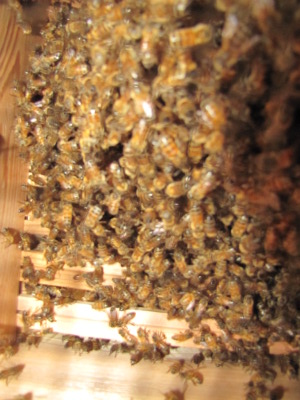 From my paucity of apiary
posts lately, you would be forgiven for thinking that when my bees
absconded, my
beekeeping enthusiasm left with them. However, the truth is that the
package we installed in our Warre hive has been bulking up nicely
--- I've just been following the rules and leaving the hive closed.
From my paucity of apiary
posts lately, you would be forgiven for thinking that when my bees
absconded, my
beekeeping enthusiasm left with them. However, the truth is that the
package we installed in our Warre hive has been bulking up nicely
--- I've just been following the rules and leaving the hive closed.
Due to the wonders of
modern technology, though, I can refrain from cracking open the hive
and can still get an idea of what's going on inside. Once a week,
I snap a shot through the screened bottom board. The photos are
generally subpar in terms of quality, but do let me keep an eye on the
bees' progress.
We installed the package
on April 27, and the first photo in this post shows what the bees
looked like two days later. They were simply a tight cluster of
bodies enclosing the queen, who was still trapped in her cage.
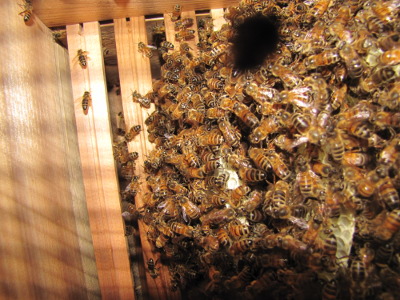
Eleven days after
installation, my non-intrusive inspection showed a little bit of comb
being built. If I'd opened the hive, I would have been able to
see whether the queen was laying, and on the off-chance she wasn't,
could have ordered a replacement queen. With a Warre hive, you
have to simply hope for the best (and pay attention to the hive's mood,
smell, and sound).
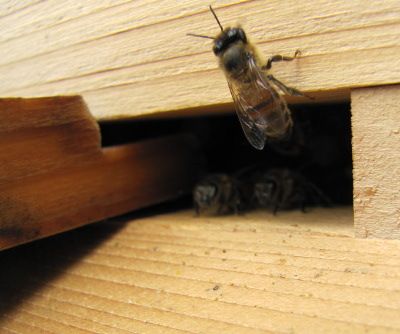 Sixteen days after
installation, I could have discovered a lot by opening the hive.
The presence of eggs would tell me the queen was still alive and well,
and now I could look at the capped brood to determine whether she had
been properly inseminated. (Lots of drone
brood and little
worker brood could be a sign of a queen who didn't have sex with enough
drones during her mating flight.) However, when I received an
improperly mated queen three years ago, I chose to let the workers supersede her and turn one of the eggs
into a queen of their choice, so the truth is I wouldn't have done
anything if I'd seen too much drone brood in the two week old hive
anyway. Of course, since I was working with a Warre hive, I
didn't even have this decision to make --- I could still see comb in my
photos (too blurry to share), and the workers were definitely bringing
pollen in, so I chose to assume all was well.
Sixteen days after
installation, I could have discovered a lot by opening the hive.
The presence of eggs would tell me the queen was still alive and well,
and now I could look at the capped brood to determine whether she had
been properly inseminated. (Lots of drone
brood and little
worker brood could be a sign of a queen who didn't have sex with enough
drones during her mating flight.) However, when I received an
improperly mated queen three years ago, I chose to let the workers supersede her and turn one of the eggs
into a queen of their choice, so the truth is I wouldn't have done
anything if I'd seen too much drone brood in the two week old hive
anyway. Of course, since I was working with a Warre hive, I
didn't even have this decision to make --- I could still see comb in my
photos (too blurry to share), and the workers were definitely bringing
pollen in, so I chose to assume all was well.
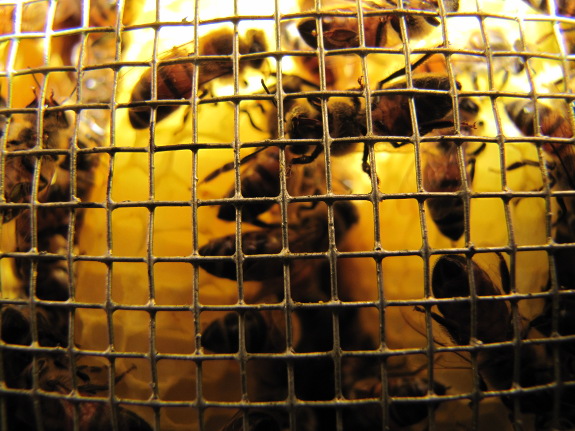
Twenty-three days after
installation (this past Sunday), I finally saw something within my hive
that required work on my part. The bottom box was starting to
look nearly full up! 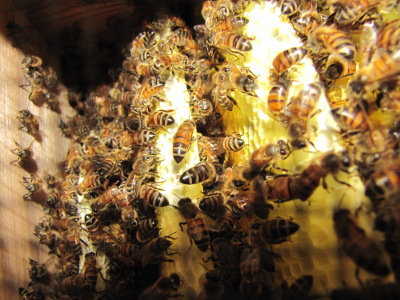 Assuming the queen is laying
well, this is about the time the first new workers should pop out of
their cappings, which means the colony could grow even more quickly
from here on out.
Assuming the queen is laying
well, this is about the time the first new workers should pop out of
their cappings, which means the colony could grow even more quickly
from here on out.
Since I started the hive
with two boxes, I can't tell whether the bees have filled the top box
as well, but there's no reason not to hoist the bees up and put another
box underneath (known as nadiring). This process preserves
the hive scent and temperature, and is the least intrusive
method of increasing a bee colony's living area. Looks like it's
time to build another box this week and take our first real peek inside
the hive since we took
out the queen cage!
Want more in-depth information? Browse through our books.
Or explore more posts by date or by subject.
About us: Anna Hess and Mark Hamilton spent over a decade living self-sufficiently in the mountains of Virginia before moving north to start over from scratch in the foothills of Ohio. They've experimented with permaculture, no-till gardening, trailersteading, home-based microbusinesses and much more, writing about their adventures in both blogs and books.
Want to be notified when new comments are posted on this page? Click on the RSS button after you add a comment to subscribe to the comment feed, or simply check the box beside "email replies to me" while writing your comment.

Mom --- Good question! Your guess is right, except that in a Warre hive, you put the new box underneath so that you don't have to take off the lid and let out the hive's heat and scent. So, to stick with your house analogy, we'll be giving the hive a basement.
In the more common, Langstroth system, the new box is called a super, but I didn't want to use that word since it implies you're putting something on top rather than underneath.